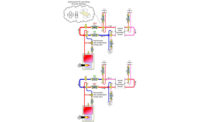There are three motors produced for use in new equipment (furnace, air handler, package) in the direct-drive residential and light commercial HVAC indoor blower motor marketplace: the permanent split capacitor (PSC) induction motor, the constant-torque electronically commutated motor (ECM) and the constant-airflow ECM, which is often referred to as a variable-speed motor. These three motors are ranked, respectively, as “good,” “better,” and “best” based on their electrical efficiencies and ability to support and/or improve system performance, IAQ, and comfort.
Indoor blower ECMs were introduced almost 30 years ago. However, PSC motors still make up approximately 50 percent of new units built in this market. Until recently, indoor blower ECMs were only built for use in new, original equipment manufacturer (OEM) units. In 2007, the first retrofit indoor blower ECM was introduced. Designed specifically to replace PSC motors, these constant-torque retrofit ECMs provided a unique opportunity for contractors and consumers.
Prior to the introduction of the retrofit indoor blower ECM, a consumer would have to replace his or her entire HVAC unit to get the benefits of ECM technology. This meant consumers with young PSC motor-driven equipment would typically wait until the end of a unit’s life to get the benefits they wanted from ECMs. With retrofit capability, however, consumers with young equipment do not have to wait to get these benefits. In addition, the cost of the retrofit is usually about the same as the cost difference between comparable new equipment built with an ECM or PSC motor.
For consumers to make an educated buying decision, contractors must be able to thoroughly explain the potential features and benefits of a motor retrofit. These include energy savings, benefits from operating the fan continuously, reduced operating noise, and improved airflow control.
ENERGY SAVNGS
During heating and cooling demands, a high-efficiency ECM can save approximately 25 percent on annual motor operating costs compared to a PSC motor. During continuous fan demand, an ECM can save up to 75 percent on annual motor operating costs due to its ability to operate at speeds slower than the operating range of a comparable PSC motor.
Most retrofit ECM manufacturers provide savings charts or calculators to quote energy savings. However, it should be noted that actual savings may differ based on regional hours of operation in heating and cooling modes and cost per kWh. It should also be noted that energy savings are based on motor run time. Always evaluate the consumer’s current usage of the PSC motor (with or without continuous fan) compared to the desired usage of the retrofit ECM. Be careful how you quote energy savings. Static energy savings charts are typically based on PSC motors that are operated continuously. If the PSC motor is not operating continuously, the energy savings will be lower; however, consumers will gain all the benefits of the continuous fan with the ECM without increasing their current energy usage.
CONTINUOUS FAN BENEFITS
Operating the indoor blower in continuous fan mode keeps the motor running when the heating and cooling demands are satisfied. This continuous air movement can reduce the temperature differences between home spaces, most notably between levels in two-story, bi-level, and tri-level homes. Continuous fan also increases the operating time of IAQ devices, such as high-efficiency filters and UV equipment.
The lower speed option for continuous fan mode built into the ECM provides the benefits of continuous fan without the noise or drafty feeling associated with PSC motor-driven systems.
It should be noted that some regions may not benefit from the energy savings and comfort benefits of operating the fan continuously. For example, in markets with high humidity, high ambient temperatures, and ductwork located in attics, operating the fan continuously could adversely affect comfort.
REDUCED OPERATING NOISE
An ECM is designed to ramp (i.e., change speed) from one operating point (including off) to another at a slower rate than a PSC motor. Often referred to as “soft start/stop,” this feature decreases the sudden noise changes that are very noticeable throughout the home.
IMPROVED AIRFLOW CONTROL
When a system’s external static pressure (ESP) increases, such as through filter loading, a constant-torque ECM will provide better airflow control than a PSC motor. However, it should be understood that airflow will not remain constant. Figure 1 shows the difference in operating characteristics between PSC motors, constant-torque ECMs, and constant-airflow ECMs when ESP changes.
Retrofit indoor blower ECMs are typically built with multi-purpose features, such as multi-horsepower, dual-voltage, and dual-rotation ratings, to reduce truck stock, and most are compatible with the existing circuit board or fan relays used in PSC-driven equipment. They are typically built in the most common frame size for this application, which is 5.6 inches in diameter and rated NEMA 48; however, in some cases, a retrofit motor mount may be required. The potential need for a new motor mount should always be evaluated before quoting a job. In addition, always consult the ECM manufacturer’s installation guide for proper mechanical installation, wiring, and operation.
SIDEBAR: TIPS FOR SELLING ECM UPGRADES
Here are some tips for successfully selling electronically commutated motor (ECM) upgrades to PSC motor-driven systems:
• Stock the motor on the truck to complete the sale that day;
• Ask your customers if they are interested in saving energy or improving indoor comfort and IAQ;
• Learn which features and benefits apply to your market or region and which do not (if any);
• Learn how to explain all of the motor’s features and benefits as if it was installed in your own home;
• Learn how to explain the energy savings and show return on investment, if applicable;
• Offer the upgrade when replacement is required of a failed PSC motor;
• Offer the upgrade to all consumers with young equipment interested in energy savings, improved comfort, and/or improved IAQ.
Christopher Mohalley is training manager, climate solutions, Regal Beloit America Inc. He can be reached at 262-552-8762 or chris.mohalley@regalbeloit.com.
Publication date: 12/5/2016
Want more HVAC industry news and information? Join The NEWS on Facebook, Twitter, and LinkedIn today!









